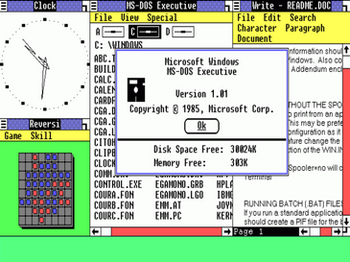 |
| Windows 1.0, the first version, released in 1985 (Photo credit: Wikipedia) |
What made Windows successful? A number of factors, but primary among them was the availability of third-party apps for the OS and immediate support for color monitors. Of course, it wouldn't be a Windows operating system if these advantages didn't come with a hefty hardware requirement.
What were the original system requirements for Windows 1.0?
Along with requiring MS-DOS 2.0 to run atop of, Windows 1.0 demanded a whopping 256 kB of RAM, an EGA graphics adapter, and either two floppy disk drives or a hard drive. This was a relatively daunting hardware setup in 1985, especially since many personal computers lacked hard drives and several models still used cassette tapes rather than floppy disks for data storage.
While color monitor support and third-party apps made the Windows franchise successful, early Windows versions didn't do well in these areas. Windows 1.0 didn't get VGA monitor support until 1987, shortly before Windows 2.0 was released. And as to apps, Microsoft didn't even port their own Excel spreadsheet to Windows until 1987, and Microsoft Word didn't get a Windows port until 1989. It wasn't until Windows 3.1 that the OS gained any serious mainstream traction; Windows 3.1 was also the first OS that Microsoft promoted with national television advertising.
That's not just a conspicuously coincidental computing conquest, it's a notoriously nostalgic nomination for the Truly Trivial.

Minor correction: Windows 1.0 required only CGA graphics. It ran in 2-color 640x200 mode. Ega graphics were a luxury.
ReplyDelete